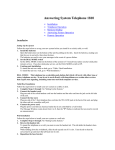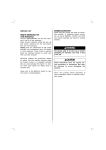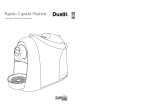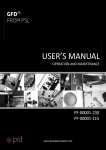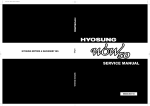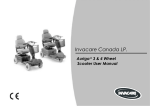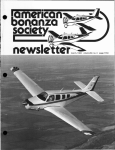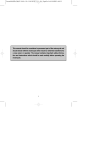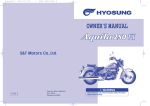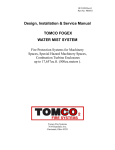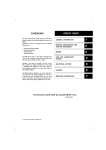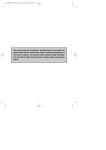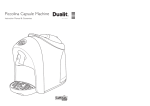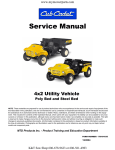Download SF 50 - Hyosung
Transcript
IMPORTANT WARNING/CAUTION/NOTE BREAK-IN INFORMATION FOR YOUR MOTORCYCLE Please read this manual and follow its instructions carefully. To emphasize special information the words WARNING, CAUTION and NOTE carry special meanings and should be carefully reviewed. The first 1,000km(600miles) are the most important in the life of your motorcycle . Proper break-in operation during this time will help ensure maximum life and performance from your new motorcycle. Hyosung parts are manufactured of high quality materials, and manufactured parts are finished to close tolerances. Proper break-in operation allows the machined surfaces to polish each other and mate smoothly. WARNING The personal safety of the rider may be involved. Disregarding this information could result in injury to the rider. CAUTION These instructions point out special service procedures or precautions that must be followed to avoid damaging the machine. Motorcycle reliability and performance depend on special care and restraint exercised during the break-in period. It is especially important that you avoid operating the engine in a manner which could expose the engine parts to excessive heat. NOTE: This provides special information to make maintenance easier or important instructions clearer. Please refer to the BREAK-IN section for specific break-in recommendations. 1 FOREWORD THANK YOU for choosing Hyosung. We at Hyosung have designed, tested and produced this motorcycle using the most modern technology available to provide you with many happy, enjoyable, safe riding. Motorcycling is one of the most exhilarating sports and insure your riding enjoyment, you should become throughly familiar with the information presented in this Owner’s Manual before riding the motorcycle. All information, illustrations photographs and specifications contained in this manual are based on the latest product information available at the time of publication. Due to improvements or other changes, there may be some discrepancies in this manual. Hyosung reserves the right to make changes at any time. Please note that this manual applies to all specifications for all respective destinations and explains all equipments. Therefore, your model may have different standard features than shown in this manual. The proper care and maintenance that your motorcycle requires are outlined in this manual. By following these instructions explicitly you will insure a long trouble-free operating life for your motorcycle. Your Hyosung dealer has experienced technicians that are trained to provide your machine with the best possible service with the right tools and equipment. HYOSUNG MOTORS & MACHINERY INC. COPYRIGHT HYOSUNG MOTORS & MACHINERY INC. 2 TABLE OF CONTENTS 1. CONSUMER INFORMATION 7. INSPECTION BEFORE RIDING 4 BRAKES TIRES GASOLINE AND ENGINE OIL LAMPS REAR-VIEW MIRRORS REFLECTOR ACCESSORY INSTALLATION AND PRECAUTION TIPS SAFE RIDING RECOMMENDATION FOR MOTORCYCLE RIDERS SERIAL NUMBER LOCATION 2. NAMES OF EACH PART 6 3. CONTROLS 7 8. PERIODIC MAINTENANCE 9 HOW TO USE THE HELMET HOLDER HOW TO OPEN THE SEAT HOW TO USE THE PERSONAL TRUNK 5. GASOLINE AND ENGINE OIL 9. MAINTENANCE TIPS 23 BRAKE LEVER FUSES BATTERY TERMINAL AIR CLEANER RUBBER CAP OF CABLES 10 HOW TO PROVIDE THE GASOLINE HOW TO SUPPLY THE ENGINE OIL 6. THE PROPER OPERATIONS 19 FRONT FORK BRAKES TIRES AIR CLEANER BATTERY TRANSMISSION OIL ENGINE OIL AND GASOLINE INSTRUMENT PANEL SWITCH 4. HOW TO USE 16 11 10. SPECIFICATIONS HOW TO START THE ENGINE HOW TO START OFF ADJUSTING THE SPEEDS HOW TO OPERATE THE BRAKE HOW TO STOP AND PARK BREAKING-IN 3 25 oscillations in the front end and lead to instability problems. Accessories added to the machine should be as light as possible and kept to a minimum. (4) The motorcycle may be affected by a lifting condition or by an instability in cross winds or when being passed or passing large vehicles. Improperly mounted or poorly designed accessories can result in an unsafe riding condition, therefore caution should be used when selecting and installing all accessories. (5) Certain accessories displace the rider from his or her normal riding position. This limits the freedom of movement of the rider and may limit his or her control ability. (6) Additional electrical accessories may over load the existing electrical system. Severe overloads may damage the wiring harness or create a dangerous situation due to the loss of electrical power during the operation of the motorcycle. 1. CONSUMER INFORMATION ACCESSORY INSTALLATION AND PRECAUTION SAFETY TIPS There are a great variety of accessories available to Hyosung owners. Hyosung can not have direct control over the quality or suitability of accessories you may wish to purchase except genuine parts. The addition of unsuitable accessories can lead to unsafe operating conditions. It is not possible for Hyosung to test each accessory on the market or combinations of all the available accessories, however, your dealer can assist you in selecting quality accessories and installing them correctly. Use extreme caution when selecting and installing the accessories for your Hyosung. We have developed some general guidelines which will aid you when deciding whether, and how to equip your motorcycle. When carrying a load on the motorcycle, mount it as low as possible and as close as possible to the machine. An improperly mounted load can create a high center of gravity which is very dangerous and makes the motorcycle difficult to handle. The size of the“load”can also affect the aerody namics and (1) In case that additional weight or aerodynamic affecting accessories are installed, they should be mounted as low as possible, as close to the motorcycle and as near the center of gravity as is feasible. The mounting brackets and other attachment hardware should be carefully checked to ensure that it provides for a rigid, nonmovable mount. Weak mounts can allow the shifting of the weight and create a dangerous, unstable condition. (2) Inspect for proper ground clearance and bank angle. An improperly mounted load could critically reduce these two safety fac tors. Also determine that the“load”does not interfere handling of the motorcycle. Balance the load between the left and right side of the motorcycle and fasten it securely. MODIFICATION Modification of the motorcycle, or removal of original equipment may render the vehicle unsafe or illegal. with the operation of the suspension steering or other control operations. (3) Accessories fitted to the handlebars or the front fork area can create serious stability problems. This extra weight will cause the motorcycle to be less responsive to your steering control. The weight may also cause SAFE RIDING RECOMMENDATION FOR MOTORCYCLE RIDERS Motorcycle riding is great fun and an exciting sport. Motorcycle riding also requires that some extra precautions be taken to ensure the safety of the rider and passenger. These precautions are: 4 WEAR A HELMET Motorcycle safety equipment starts with a quality safety helmet. One of the most serious injuries that can happen is a head injury. ALWAYS wear a properly approved helmet. You should also wear a suitable eye protection. SERIAL NUMBER LOCATION The frame and/or engine serial numbers are used to register the motorcycle. They are also to assist your dealer in terms of ordering parts or referring to special service infor mation. RIDING APPAREL Loose fancy clothing can be uncomfortable and unsafe in terms of riding your motorcycle. Choose good quality motorcycle riding apparel in terms of riding your motorcycle. INSPECTION BEFORE RIDING Review throughly the instructions in the “INSPECTION BEFORE RIDING”section of this manual. Do not forget to perform an entire safety inspection to ensure the safety of the rider and its passenger. FAMILIARIZE YOURSELF WITH THE MOTORCYCLE Your riding skill and mechanical knowledge form the foundation for safe riding practices. We suggest that you practice riding your motorcycle in a non-traffic situation until you are thoroughly familiar with your machine and its controls. Remember practice makes perfect. KNOW YOUR LIMITS Ride within the boundaries of your own skill at all times. Knowing these limits and staying within them will help you to avoid accidents. The frame number ① is stamped on the right side of the frame under the footboard. The engine serial number ② is stamped on the up side of the crankcase assembly. BE EXTRA SAFETY CONSCIOUS ON BAD WEATHER DAYS Riding on bad weather days, especially wet ones, requires extra caution. Braking distances double on a rainy day. Stay off of the painted surface marks, manhole covers and greasy appearing areas as they can be especially slippery. Use extreme caution at railway crossings and on metal gratings and bridges. Whenever you have a doubt about road condition, slow down! Please write down the numbers in the box provided below for your future reference. Frame number: Engine number: 5 2. NAMES OF EACH PARTS ① Rear brake lever ② Turn signal switch ③ Horn switch ④ Ignition switch ⑤ Starter switch ⑥ Light switch ⑦ Throttle grip ⑧ Front brake lever ⑨ Fuel tank ⑩ Personal trunk ⑪ Oil tank ⑫ Rear carrier ⑬ Muffler ⑭ Air cleaner ⑮ Battery & Fuse � Seat lock � Helmet holder � Center stand � Kick start lever ∙“ ” means the invisable parts 6 remaining amount of oil has become approximately 0.23ℓ. 3. CONTROLS INSTRUMENT PANEL CAUTION The lack of Engine oil could cause serious damages on the Engine. SWITCH ① IGNITION SWITCH The ignition switch has three positions: F ON KEY G PUSH The speedometer indicates the road speed in kilometers per hour. NITIO N OF ① SPEEDOMETER ② ODOMETER The odometer registers the total distance that the motorcycle has been ridden. I LOCK ③ FUEL GAUGE It indicates the remaining fuel amount in the fuel tank. E indicates the fuel tank is empty or nearly so. (the remaining fuel is 1.3ℓ at E. the capacity is 4.8ℓ) ◉ (ON)POSITION The ignition circuit is completed and the engine can now be started. The key cannot be removed from the ignition switch in this position. Fill the fuel tank before E. (OFF) POSITION ◉ All electrical circuits are cut off. CAUTION (LOCK) POSITION ◉ To lock the steering, turn the handlebar all the way to the left. Push down and turn key to the (LOCK) The fuel gauge indicates the remaining amount whenever the ignition switch is (ON) or (OFF). For checking the remaining amount of fuel, put the motorcycles on the center-stand and set the ignition (ON). switch is position and remove the key. All electrical circuits are disconnected. G ⑤ OIL INDICATOR LIGHT When the engine oil level in the tank becomes too low requiring“HYPOL OIL”refilling. the indicator NITI PUSH When turn signals are being operated. the indicator will flash intermitently. ON ④ TURN SIGNAL INDICATOR LIGHT I will light. When the oil level check light turns on, the PUSH 7 For preventing steal, Lock the steering. ⓐ Turn right the handle. (Lock). ⓑ Turn the key from (OFF) to ⓒ Pull out the key while from (Lock) to HORN SWITCH (OFF). CAUTION ● Check if the steering is locked. ● When it is not locked, Turn the handle right a little. Press the switch to operate the horn. ④ LIGHT SWITCH ② TURN SIGNAL SWITCH LIGHT SWITCH TURN SIGNAL SWITCH ◉“ ”position The headlamp, meter lamp and taillamp come on. If not start engine, do not come on. It is for left/right turning or changing lanes. ◉“ �”position - for right turn signal ◉“� ”position - for left turn signal ◉“ ◉“ △ ”Push the switch to cancel the operation. ”position The headlamp, meter lamp and taillamp go off. CAUTION Turn off the lamp right after completing the turn or lane change. If you keep the lamp on, it could cause other drivers to be confused. ③ HORN SWITCH 8 ⑤ STARTER SWITCH 4. HOW TO USE HOW TO USE THE HELMET HOLDER STARTER SWITCH When keep a helmet temporally, use the helmet holder following the illustration below. HELMET HOLDER Push in the electric starter switch to rotate the starting motor. NOTE: If the front or rear brake lever is not squeezed, the starter motor will not rotate. CAUTION When the starter motor doesn’ t rotate within 5 seconds after pushing the switch, try again after 10 seconds for preventing the damage on battery. HOW TO OPEN THE SEAT You can use the Trunk after opening the seat. 1) To unlock the seat, insert the ignition key into the lock and turn it counterclockwise. 2) To lock the seat, push clown firmly until the seat latch snaps into the locked position. 9 5. GASOLINE AND ENGINE OIL HOW TO USE THE PERSONAL TRUNK Keep the maintenance manual in the personal trunk. Put the helmet as shown in the picture. HOW TO PROVIDE THE GASOLINE 1. Insert the ignition key into the lock located a center of the footboard and turn it counterclockwise. 2. Open the fuel tank cover as it lift up lightly. 3. Turn the fuel tank cap left. 4. Fill the fuel tank and turn the cap right tightly. CAUTION ● The trunk could be heated. Don’t keep anything that doesn’t endure heat. ● Don’ t keep the fragile. ● Check if it is locked. ● The unlocking of trunk could cause serious accident. ● Take care not to spill the oil in the trunk. ● Don’ t allow water to get inside the trunk or it could damage. ● Don’t wash the trunk with water. Use the vacuum cleaner. ● Don’ t keep the valuables in the trunk when leaving unattended. GASOLINE WARNING ● When refueling, always shut the engine off and turn the ignition. Key to the (OFF) position. Never refuel near an open flame. ● Do not overfill the fuel tank. Do not fill the fuel tank above the bottom of the filler tube as shown in the illustration. 10 6. THE PROPER OPERATIONS CAUTION Take care not to spill gasoline during refueling. HOW TO START THE ENGINE HOW TO SUPPLY THE ENGINE OIL � Open the seat. Before riding � Turn the oil tank cap left. ● Check how much the engine oil and gasoline is left. ● Put the motorcycle on the centerstand. � Fill the oil tank and tighten it. (Use the recommended oil) OIL TANK CAP G WARNING (ON). NITION PUSH � Set the ignition switch I A burnt engine is usually a result of engine starting with no oil in the oil tank. Check the oil level before starting to avoid seriously damage. � Squeeze the rear brake lever. CAUTION ● Don’ t mix the unrecommended oil. It could damage the engine. ● When refilling the oil tank, Don’ t allow the dust to get inside. ● Mop the oil spilt. ● Don’t put the patch on the cap. It could disturb the oil to be provided and damage the engine. 11 � Push the start switch without turning the ● It is not started easily in the cases as follows. 1) It has been long since you started the motorcycle. throttle grip. 2) There was no gasoline left. In this case(1.2), push the start button longer without turning the throttle grip. � When the engine is cold, idle it for a while. WARNING ● Don’ t idle it indoor where there is little or no ventilation available. ● The exhaust gas including carbon monoxide is extremely poisonous. CAUTION � Start using by the kick starter lever ● Depress the start switch right after started. ● When the start motor doesn’t rotate within 5 seconds after pushing the start switch, try again after 10 seconds for preventing the damage on battery. You can start using by the kick starter lever when there is some problem in battery. � Put the motorcycle on the center stand. � Set the ignition switch (ON). � Press forcefully the kick starter lever. ● Wnen it doesn’ t start after several trial, turn the throttle grip to ⅛~¼ position. FULL THROTTLE OPERATION CAUTION CAUTION When started, return the kick starter lever. When started, return the throttle grip. 12 CAUTION HOW TO START OFF Don’t let the engine run excessively before riding. � Return the center stand. For returning the center stand, push the motorcycle forward gripping the rear brake lever with left hand and the rear carrier with right hand. � Check the safety Turn on the left turn signal lamp and check the safety. Grip up the rear brakd lever. CAUTION WARNING When returning the center stand, Don’t grip the seat. Be careful of the vehicles in back. � Ride on � Start off Gripping the lever with both hands, be seated on from leftside of the motorcycle. Put the left foot on the earth and fasten the rear brake lever. Depress the rear brake lever and turn the throttle grip slowly, the motorcycle will start moving forward. SLOWLY 13 ● Grip the brake lever right after returning the WARNING throttle grip. ● Make the speed lower by operating the brake When turned the throttle grip excessively, it will make quick start which is dangerous. slowly. WARNING ADJUSTING THE SPEEDS ● Using either front or rear brake is dangerous and can cause skidding and loss of control. � The quick brake can cause skidding. RETURNING TURNING You can adjust the speeds with the throttle grip. Turning - - - - Get faster Returning - - - Get slower � Pay much more attention to driving when rains or snows. HOW TO OPERATE THE BRAKE ● When the brake doesn’ t work normally, keep low speeds and apply the brake lightly until smoothly operated. Apply the front and rear brakes at the sametime. REAR BRAKE FRONT BRAKE 14 � Lock the steering for security. � Pull the ignition key out of the lock and keep it yourself. HOW TO STOP AND PARK � Turn on the turn signal lamp and return the throttle grip. BREAKING-IN During mamufacture only the best possible materials are used and all machined parts are finished to a very high standard but it is still necessary to allow the moving parts to“BREAK-IN”before subjecting NITION the engine to maximum stresses. The future performance and reliability of the engine depends on the care and restraint exercised during its early life. The general rules are as follow: G PUSH � When completely stopped, turn off the (OFF) turn signal lamp. Set the key position. I ● Keep to these breaking-in speed limit: Up to 1,000km(600miles):Less than 1/2 throttle ● Upon reaching an odometer reading of 1,000km(600miles) you can subject the motorcycle to full throttle operation. ● Do not maintain constant engine speed for an � Put the motorcycle on the center stand. extended time period during any portion of the break-in. Try to vary the throttle position. CAUTION Don’ t park the motorcycle on the slippery or tilted surface. 15 � BRAKE FLUID 7. INSPECTION BEFORE RIDING ● Keep the motorcycle upright and place the handlebar straight. ● Check brake fluid level by observing the middle line on the brake fluid reservoir. ● When the level is below the middle line, replenish with brake fluid. Running inspection once in a day and periodic maintenance(4,000km or 8,000km)is necessary for the full performance and preventing accidents. CAUTION ● Even though the motorcycle is not run for a long time, the periodic maintence is necessary. ● The engine and muffler are too hot right after engine stopped. please be caerful not to be burned. ● Don’t inspect the engine indoor where there is little or no ventilation available. The exhaust gas is extremely poisonous. MIDDLE LINE BRAKES � THE BRAKE LEVER TIRES ● Turn the front/rear brake adjuster clockwise/or counterclockwise to obtain the specified play. ● After adjusting the play, check there is no � THE TIRE PRESSURE If you see the problem with the tire, adjust the pressure with the pressure gauge. 5-20mm 15-25mm dragging and enough clearance between the brake lever and grip when the lever is tightly squeezed. OVER 16 NORMAL SHORT CAUTION GASOLINE AND ENGINE OIL If there are some problem with the tire pressure or cracks and cuts, it will decrease the riding stability and lead to flat tire. � THE GASOLINE ● Check if the remaining gasoline is enough for running to the destination. ● Replenish the gasoline before reaching“E” (ON) mark with the ignition switch in the position. � CRACKS AND CUTS Check if 1) there are visible cracks and cuts. 2) there are pebbles stuck. FUEL GAUGE SCREW WORN, CRACK � FUEL RECOMMENDATION ● Use unleaded gasoline with an octane rating of 85~95 or higher (Research method). Unleaded gasoline can extend spark plug life and exhaust components life. ● If pinking or knocking is experienced, substitute higher octane grade gasoline or another brand, because there are differences between brands. FOREIGN MATERIAL � THE DEPT OF TIRE TREAD Change the tire if the remaining depth tire tread becomes 1.6mm(0.06inch)or less. WEAR LIMIT INDICATION � ENGINE OIL ● Replenish the Engine oil when the Engine oil indicator light is on with the ignition switch in (ON)position. the WEAR LIMIT INDICATION POSITION MARK OIL INDICATOR LIGHT 17 CAUTION REAR - VIEW MIRROR The lock of engine oil will damage engine severely. Check if the mirror shows the rear and/or side views. LAMPS ● Check if the head lamp, tail lamp and turn signal lamp work well with the engine started. ● Check if the lamp are dusty or damaged. REFLECTOR HEAD LAMP ● Check if the reflector is dusty or damaged. TURN SIGNAL LAMP TAIL LAMP TURN SIGNAL LAMP 18 � CHASSIS 8. PERIODIC MAINTENANCE The belows show the schedule of periodic maintenance by mileages. More frequent maintenance must be performed on motorcycles that are used under severe conditions. Throttle cable Every 4,000km Every 8,000km Motor oil ← - - - Grease Inspect Inspect Inspect Every 4,000km Every 8,000km - - Inspect Brake Inspect ← - Tire Inspect ← - Bolt / Nut Inspect ← - Steering Inspect ← - Drive belt � LUBRICATION First 1,000km First 1,000km FRONT FORK Throttle grip Brake hose, cable Bearing of Steering stem Brake lever ● Check if there is any noise by bend of front fork while moving the handle upward and downward. ● Inspect whether the steering stem is well Grease every 2years or every 20.000km Grease ← - First 1,000km Every 4,000km Every 8,000km Tighten ← - assembled while moving front fork up/ downwards and/or foreward/backward. � ENGINE Engine bolt/nut Air cleaner Clean every 3,000km Spark plug Clean Clean Replace Carburetor Inspect ← - Inspect ← - BRAKES Engine hose Replace every 2years ● Turn the front/rear brake adjuster clockwise or counterclockwise to obtain the specified play. 19 5-20mm 15-25mm MIDDLE LINE ● Check the front/rear brake while running in low speeds. ● Check if there is leakage or damage on the BRAKE PADS brake fluid reservoir and the connected parts are loose. ● Check if the vibration damages the brake hose ● Wearing condition of brake pads can be checked by observing the wear limit line on the pads. When the wear exceeds the limit line, replace the pads. while moving the handle left/right or running. BRAKE HOSE WEAR LIMIT LINE DISC BRAKE CALIPER BRAKE FLUID ● How to replenish with brake fluid 1. Clean the brake fluid reservoir around not to allow dusts to get inside of it. 2. Loosen the screw and open the cap. 3. Replenish with brake fluid to the limit line. the recommended brake fluid:DOT4 4. Fasten the cap. ● Keep the motorcycle upright and place the handle straight. ● Check the brake fluid level by observing the middle line. ● When the level is below the lower the middle line, check if there is leakage. 20 UPPER LIMIT LINE CAUTION AIR CLEANER ● Don’t replenish with brake fluid over the limit line. It will leak out of the brake fluid reservoir. ● Be careful not to allow dusts or water to go inside when it is replenished. ● Don’t use the unrecommended brake fluid. ● Brake fluid can damage severely the plastics or rubbers. When it is spilt on the parts, mop them up. 1. Take out air cleaner by disassembling 2 screws. 2. Put out the filter. TIRES Check the tire pressure when it is cold. Tire Pressure Front Rear Solo riding 1.25 kg/㎠ 2.00 kg/㎠ Dual riding 1.75 kg/㎠ 2.25 kg/㎠ yyyyyyyyy ;;;;;;;;; ;;;;;;;;; yyyyyyyyy ;;;;;;;;; yyyyyyyyy ;;;;;;;;; yyyyyyyyy ;;;;;;;;; yyyyyyyyy ;;;;;;;;; yyyyyyyyy ;;;;;;;;; yyyyyyyyy ;;;;;;;;; yyyyyyyyy 21 CAUTION ENGINE OIL AND GASOLINE ● When the assembly of air cleaner filter is not completely done, dusts can go inside and damage severely engine. ● Be careful not to allow water to go into the filter while washing. ● Check if there is leakage around the oil pump and oil tank. BATTERY ● This motorcycle is equipped with sealed MF battery. ● Maintaining the battery does not need. CAUTION ● Check if there is leakage from gasoline tank, hose and carburetor. ● Don’t take off the sealed cap. ● Take off the battery when the motorcycle is not used for a long time to prevent electric discharge or leakage. When the battery is attached on the motorcycle, take off the (-) terminal. yy ;; ;; yy TRANSMISSION OIL Check if the transmission oil leaks. 22 9. MAINTENANCE TIPS FUSES Check the fuse with the ignition switch BRAKE LEVER (OFF) 1. Remove the battery cover under the pillion seat. 2. Take out the fuse holder. 3. Open the fuse holder and take out the fuse. Check if it is within the required range when you squeeze the brake lever until feel the resistance. FUSE PIN RANGE ADJUSTER NUT CAUTION ● When it is beyond the required range, replace the brake shoe. ● Fix � part of nut to pin or the serious accident can be caused by the brake failure. CAUTION ● Always be sure to replace the blown fuse with the correct amperage fuse. ● If the replaced fuse is blown in a short time, it means there are other problems. Check the other parts. ● Don’t pour water on the fuse box when washing. 23 BATTERY TERMINAL NON-FLAMMABLE CLEANING SOLVENT Clean the battery terminal when it is dusty or rusted. 1. Deassemble the cover of battery box. (OFF) position. 2. Set the ignition switch OIL 3. Clean the terminal. If there is white dust, clean it with warm water. 4. Assemble the battery wires and grease the terminal lightly. CAUTION ● Don’t use the cleaning solvent whose flash point is low when cleaning the filter. ● Assemble the filter completely or damage severely the engine. ● Be careful not to allow water to go inside the air cleaner filter. RUBBER CAP OF CABLES CAUTION Mop them up with a patch when washing. ● Keep the battery away from fires. ● When disassemble the battery wires, take off � terminal first with the ignition switch (OFF) position. When assemble, � terminal first. AIR CLEANER RUBBER CAP 1. Take off the air cleaner filter. 2. Wash it with cleaning solvent and dry. 3. Immerse it in motor oil squeeze the oil off to make it slightly wet with oil. 4. Assemble the air cleaner filter. 24 10. SPECIFICATIONS DIMENSIONS AND DRY MASS Overall length Overall width Overall height Wheelbase Ground clearance Dry mass 1,825mm(71.9in) 635mm(25.0in) 1,110mm(43.7in) 1,270mm(50.0in) 125mm(4.9in) 88kg(194lbs) ENGINE Type Intake system Number of cylinder Bore Stroke Piston displacement Two-stroke, forced air cooled Reed valve 1 41.0mm(1.614in) 37.4mm(1.472in) 49㎤(3.0cu.in) Corrected Compression ratio Carburetor Starter system 7.4:1 SIDEDRAFT VARIABLE VENTURI(PISTON) KICK/SELF STARTER TRANSMISSION Clutch Reduction ratio Drive system Dry shoe, automatic, centrifugal type 2.997~0.813 V-belt drive 25 CHASSIS Front suspension Rear suspension Caster Telescopic type Coil spring type 25。 Trail Steering angle 75mm(2.95in) 45。 (right & left) Front tire size Rear tire size Front brake Rear brake 110/70-12 47J 120/70-12 51J Disc Drum ELECTRICAL Ignition type “CDI”type Ignition timing 20。 B.T.D.C.at 1,000 rpm Spark plug Battery Generator Fuse Headlamp B8HS 12V 3Ah/10HR Magneto 10A 15W×2 Turn signal lamp 10W×4 Tail/Brake lamp Speedometer lamp 5/10W 1.7W×2 Oil level indicator lamp Turn signal indicator lamp 1.7W 1.7W CAPACITIES Fuel tank 4.8ℓ 1.0ℓ Engine oil tank 110cc(Replace) 130cc(Overhaul) Transmission oil 26 WARNING Noise Control System (muffler assembly) TAMPERING WITH NOISE CONTROL SYSTEM PROHIBITED Owners are warned that the law may prohibit : (a) The removal or rendering inoperative by any person other than for purpose of maintenance, repair or replacement, of any device or element of design incorporated into any new vehicle for the purpose of noise control prior to its any sale of delivery to the ultimate purchaser or while it is in use ; and (b) The use of the vehicle after such device or element of design has been removed or rendered inoperative by any person. MAINTENANCE : The exhaust system of this motorcycle requires no periodic maintenance. The engine should be adjusted to the manufacturer s specifications and the spark plug should be kept in good condition. Running the engine with incorrectly operating spark plug or misadjusted carburetor may cause permanent damage to the catalyst and to the noise control system. Prepared by HYOSUNG MOTORS & MACHINERY INC. 1st Ed. MAY. 1999 Printed in KOREA




























